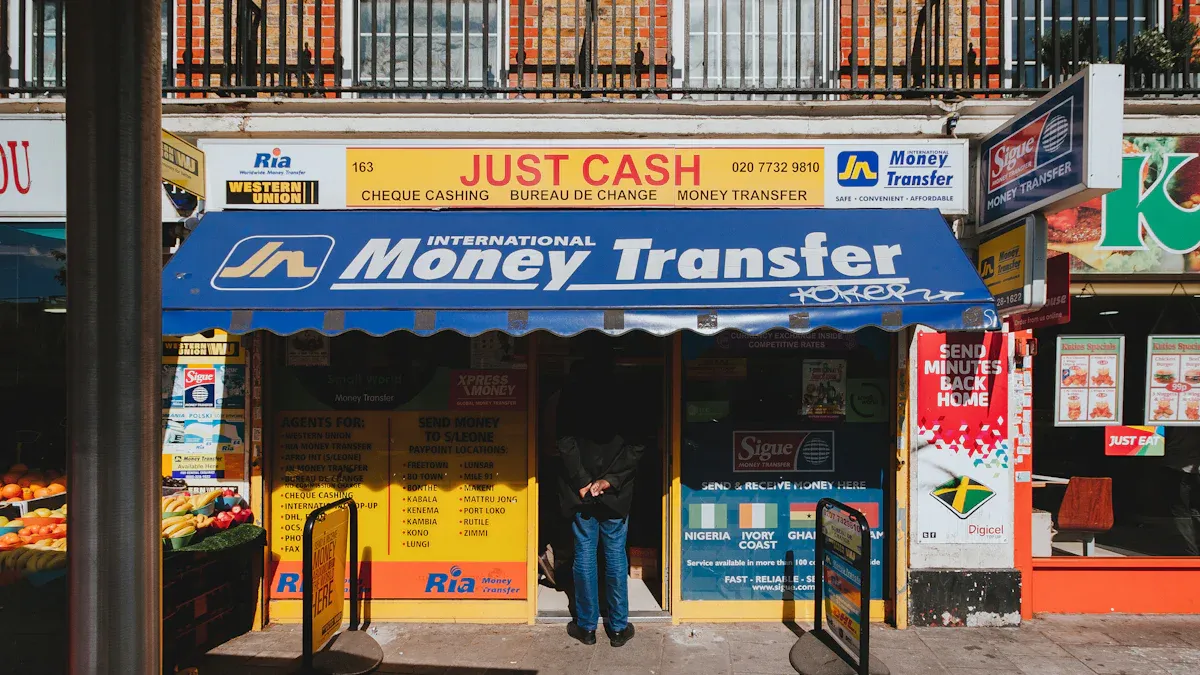- EasyCard
- Trade
- Help
- Announcement
- Academy
- SWIFT Code
- Iban Number
- Referral
- Customer Service
- Blog
- Creator
Can You Send Money via Courier from the United States to Mexico

Image Source: pexels
You cannot send money by courier from the United States to Mexico. Strict laws and regulations exist to prevent people from using couriers to send cash or monetary instruments across borders.
- You must declare if you carry $10,000 or more in currency or monetary instruments when entering or leaving the US.
- Sending large amounts of money can raise suspicion of illegal activity, especially when linked to Mexico.
- Banks and carriers face strict anti-money laundering rules, and authorities closely watch for bulk cash smuggling.
Trying to send money to Mexico with a courier puts your money at risk of loss, theft, or legal trouble. If you want to send money to Mexico, you need to use safe and legal methods instead of trying to send cash through a courier.
Key Takeaways
- You cannot send cash or money by courier or mail from the U.S. to Mexico because it is illegal and unsafe.
- Couriers and the postal service have strict rules that block sending cash, coins, checks, or valuables to Mexico.
- Sending money this way risks loss, theft, legal fines, and even jail time if you break the law.
- Safe options include electronic bank transfers, trusted money transfer services, and secure apps like Western Union and Remitly.
- Always check fees, confirm recipient details, and use legal methods to protect your money and avoid trouble.
Courier and Postal Restrictions

Image Source: pexels
Sending Cash by Courier
If you want to send money to Mexico, you might think about using a courier service like UPS, FedEx, or DHL. These companies do not allow you to send cash or any kind of money in packages. Their rules are strict because sending cash by courier can lead to theft, loss, or even legal trouble. You cannot hide money in a box or envelope and hope it will reach Mexico safely. Couriers have clear policies that stop you from sending cash, coins, or checks in shipments. If you try to send money this way, the courier may refuse your package or report it to authorities.
Tip: Always check the rules of any courier before you try to send money or valuable items. Couriers want to protect you and themselves from risk.
You should know that sending money by courier is not only against company rules but also puts your funds in danger. Packages can get lost or stolen. If this happens, you have no way to recover your money. Using a courier to send cash or monetary instruments to Mexico is not a safe or legal method.
Postal Service Policies
The United States Postal Service (USPS) has its own set of rules for sending money to Mexico. You cannot mail coins, banknotes, or currency notes to Mexico. The USPS also bans securities payable to bearer and traveler’s checks. If you try to send these items, the postal service will stop your package. Other valuable items, such as precious metals, stones, jewelry, and watches, are also not allowed in Express Mail Service (EMS) shipments to Mexico.
- Mailing coins, banknotes, and currency notes to Mexico is prohibited.
- You cannot mail securities payable to bearer or traveler’s checks.
- Precious metals, stones, jewelry, and watches are not allowed in EMS shipments to Mexico.
USPS used to offer international money orders, but this service ended on September 30, 2024. If you have an old international money order, you can cash it at a Post Office until September 30, 2025. After that date, you must fill out a special form to get help with lost or uncashed money orders. USPS does not list any new ways to send money to Mexico after stopping international money orders.
- USPS stopped selling international money orders to Mexico on September 30, 2024.
- You can cash existing money orders at Post Offices until September 30, 2025.
- After that, you must use a form to ask about lost or uncashed money orders.
- USPS does not offer new options for sending money to Mexico after this change.
If you want to send money to Mexico, you should not use the postal service to send cash or monetary instruments. Mailing money is risky and not allowed. You should look for safer and legal ways to transfer funds.
Note: Mailing money or valuable items to Mexico can lead to loss, theft, or legal problems. Always use approved methods to send money to Mexico.
Legal and Safety Risks
Laws on Sending Money
When you send money from the United States to Mexico, you must follow strict laws. U.S. law requires you to report if you transport more than $10,000 in cash or monetary instruments by mail or courier. You must file a FinCEN Form 105 with U.S. Customs and Border Protection. If you do not report, you risk losing your money, facing fines up to $500,000, or even going to prison for up to 10 years. The Bank Secrecy Act and other rules target illegal money transfers and bulk cash smuggling. These laws also cover prepaid cards and stored value devices, which some people use to avoid detection. U.S. authorities use dogs and x-ray machines to find hidden money in packages.
Some businesses, like banks and licensed carriers, have special rules and may not need to report every transfer. However, if you try to send money without following the law, you can face criminal charges. In one case, a company lost over $50 million for illegal money transport. If you try to send money illegally to Mexico, you could face arrest, prosecution, and heavy fines. Mexican law also punishes illegal money transfers, and you may get little help from U.S. officials if you get caught.
Note: Always use legal and approved ways to send money to Mexico. Breaking the law can lead to serious trouble.
Risks of Sending Funds to Mexico
Sending funds to Mexico by courier or mail puts your money at great risk. Packages can get lost, stolen, or stopped by customs. If this happens, you may never see your money again. Couriers and postal services do not insure cash or monetary instruments. Even if you try to hide money in a package, customs officers have tools to find it.
You also face privacy issues. Banks and money transfer services must report large transfers and may ask for documents to prove where your money comes from. Money exchange businesses along the border collect personal information for cash transactions. These rules help stop money laundering and crime, but they can make sending money harder for you.
- Loss, theft, and non-delivery are common risks when you send money by courier.
- Legal penalties can include fines, jail time, and loss of your money.
- Privacy concerns may arise due to strict reporting and identification rules.
If you want to transfer money to Mexico, always choose safe and legal methods. Avoid sending cash or monetary instruments by courier. This protects your money and keeps you out of legal trouble.
Safe Ways to Send Money to Mexico

Image Source: unsplash
When you want to transfer money to Mexico, you have many safe and legal options. Most people use electronic transfers or authorized money transfer services. These methods protect your funds and help you avoid the risks of mailing cash.
Electronic Transfers
Electronic transfers are one of the best ways to send money to Mexico. You can use your bank’s online platform to transfer money directly to a bank account in Mexico. This method is secure and traceable. Financial experts agree that electronic transfers help you avoid theft or loss. Many banks in the United States and Mexico support international transfers. You can choose to send money using a debit card, credit card, or bank account. Some banks may charge a fee, so always check the rates before you transfer money.
Tip: Electronic transfers are safe because banks use strong security systems and real-time monitoring to protect your money.
Money Transfer Services
Money transfer services give you more options to send money to Mexico. Companies like Western Union, MoneyGram, and Ria are popular choices. These money transfer providers offer cash pickup, bank deposit, and even home delivery in some areas. Consumer Reports found that services like Ria offer competitive fees and reliable delivery times. Western Union and MoneyGram have large networks in Mexico, so your family can pick up cash at thousands of locations. Remitly is another trusted provider, offering both fast and economy transfer speeds. You can compare fees and exchange rates to find the best way to send money.
| Service | Transfer Fees | Exchange Rate Markup | Payment Options |
|---|---|---|---|
| Remitly | $0 for first transfer, then varies | 1%-3% | Debit, credit, bank |
| MoneyGram | Flat or % based | Up to 5% | Debit, credit, bank |
Note: Always check the total cost, including fees and exchange rates, before you transfer money to Mexico.
Digital Apps to Transfer Money to Mexico
A money transfer app makes it easy to send money to Mexico from your phone or computer. Apps like Remitly, Western Union, and Xoom are widely used. These apps let you transfer money quickly and track your transfer in real time. Remitly allows you to send up to $25,000 USD per transfer, with options for bank deposit, mobile wallet, or cash pickup. Western Union’s app offers many payment methods and strong security features. Most money transfer apps use encryption and fraud prevention tools to keep your money safe. You should always verify the recipient’s information and use a strong password for your account.
| App Name | Max Transfer Limit | Delivery Options | Security Features |
|---|---|---|---|
| Remitly | $25,000 | Bank, wallet, cash pickup, home delivery | Encryption, tracking |
| Western Union | Not specified | Cash pickup, bank deposit, app tracking | PCI DSS compliance |
Over 98% of personal remittances from the United States to Mexico use electronic or authorized in-person transfer services. This shows that most people trust these money transfer providers for safe and fast money transfers.
If you want the best way to send money, always choose electronic transfers, trusted money transfer services, or a secure money transfer app. These options help you transfer money to Mexico safely and legally.
You should never send money to Mexico by courier. This method is illegal and unsafe. Instead, choose secure ways to transfer money. Use trusted banks, money transfer services, or digital apps. These options protect your funds and follow the rules set by both the United States and Mexico.
- Sending money by courier can lead to loss, theft, or legal trouble.
- Safer choices include electronic transfers and regulated services.
- Always double-check recipient details and compare fees before you send money.
For more help, you can check resources from the U.S. Department of State or Mexico’s consumer protection agencies.
FAQ
Can you send cash to Mexico using UPS, FedEx, or DHL?
You cannot send cash with UPS, FedEx, or DHL. These companies do not allow cash or checks in packages. If you try, they may refuse your shipment or report it to authorities.
What happens if you mail money to Mexico and it gets lost?
If you mail money and it gets lost, you cannot get it back. Postal and courier services do not insure cash or monetary instruments. You risk losing your money forever.
Are there legal penalties for sending money by courier to Mexico?
Yes. If you send money by courier and break the law, you may face fines or jail time. U.S. law requires you to report large amounts. Authorities can seize your money if you do not follow the rules.
What is the safest way to send money to Mexico?
Use electronic transfers or trusted money transfer services. These methods protect your funds and follow the law. Services like Western Union, Remitly, and Xoom offer secure options for sending money to Mexico.
Sending money to Mexico for travel or business doesn’t have to be costly or risky. With BiyaPay’s EasyCard, you can transfer funds securely across 190+ countries with no annual fee, perfect for cross-border payments. Supporting real-time conversion of 30+ fiat currencies and 200+ cryptocurrencies, BiyaPay offers transparent exchange rates and fees as low as 0.5%, far below traditional bank charges. Whether paying for vacation expenses or supporting family, BiyaPay ensures fast, compliant transactions via platforms like PayPal. Setup takes minutes, letting you focus on your goals. Avoid the pitfalls of illegal courier methods and choose a trusted solution used by over 500,000 users globally. Ready to simplify your international payments? Sign up for BiyaPay now and send money with ease!
*This article is provided for general information purposes and does not constitute legal, tax or other professional advice from BiyaPay or its subsidiaries and its affiliates, and it is not intended as a substitute for obtaining advice from a financial advisor or any other professional.
We make no representations, warranties or warranties, express or implied, as to the accuracy, completeness or timeliness of the contents of this publication.




Contact Us
Company and Team
BiyaPay Products
Customer Services
is a broker-dealer registered with the U.S. Securities and Exchange Commission (SEC) (No.: 802-127417), member of the Financial Industry Regulatory Authority (FINRA) (CRD: 325027), member of the Securities Investor Protection Corporation (SIPC), and regulated by FINRA and SEC.
registered with the US Financial Crimes Enforcement Network (FinCEN), as a Money Services Business (MSB), registration number: 31000218637349, and regulated by FinCEN.
registered as Financial Service Provider (FSP number: FSP1007221) in New Zealand, and is a member of the Financial Dispute Resolution Scheme, a New Zealand independent dispute resolution service provider.




















